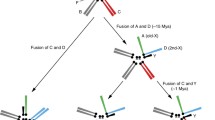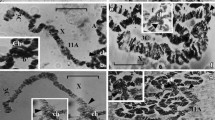Abstract
Drosophila pseudoobscura has three acrocentric autosomes. In the experiments reported, homologous arms of the third chromosome were attached to the same centromere. This is a ‘reversed metacentric compound’ third chromosome, denoted by C(3)RM. This compound chromosome is relatively fertile in within-strain crosses (ca. 50% egg hatch) but sterile when outcrossed to a normal karyotype. When constructing translocations for this experiment, the behavior of the Y-autosome translocations suggested that this species can tolerate more Y chromosome deficiency while retaining fertility than canDrosophila melanogaster. Finally, there were no Robertsonian exchanges observed among the 96 autosome-autosome translocations analyzed cytologically.
Similar content being viewed by others
References
Cobbs, G., Dillihay, L. & Gorden, L., 1988. Male-sex-ratio trait in Drosophila pseudoobscura: Frequency of autosomal aneuploid sperm. Genetics, in press?
Fitz-Earle, M. & Holm, D. G., 1976. The application of compound autosomes to insect control, including the first experimental success with compound-fragment combinations. Proc. XV Int. Congr. Entomol., pp. 146–155.
Foster, G. G., Whitten, M. J. & Konowalow, C., 1976. The synthesis of compound autosomes in the Australian sheep blowfly, Lucilia cuprina. Can. J. Genet. Cytol. 18: 169–177.
Gatti, M., Tanzarella, C. & Olivieri, G., 1974. Analysis of the chromosome aberrations induced by X-rays in somatic cells of Drosophila melanogaster. Genetics 77: 701–719.
Harshman, L. G., 1977. A technique for the preparation of Drosophila salivary gland chromosomes. Dros. Inf. Serv. 52: 164.
Lindsley, D. L. & Sandler, L., 1963. Construction of the compound X chromosomes in D. melanogaster by means of the Bar Stone duplication.’ In: Methodology in basic genetics, pp. 390–403. Ed. W. S.Biordette, Holden-Day, San Francisco.
Novitski, E., 1946. Triploidy in D. pseudoobscura. Dros. Inf. Serv. 20: 89.
Novitski, E., Grace, D. & Strommen, C., 1981. The entire compound autosomes of D. melanogaster. Genetics 98(2): 257–273.
Pal, R. & Whitten, M. J., 1974. The use of genetics in insect control. Elsevier/North-Holland, Amsterdam.
White, M. J. D., 1978. Modes of speciation. W. H. Freeman, San Francisco.
Author information
Authors and Affiliations
Rights and permissions
About this article
Cite this article
Harshman, L.G., Prout, T. Synthesis of an attached autosome, C(3)RM, inDrosophila pseudoobscura . Genetica 80, 87–91 (1990). https://doi.org/10.1007/BF00127128
Received:
Accepted:
Issue Date:
DOI: https://doi.org/10.1007/BF00127128




